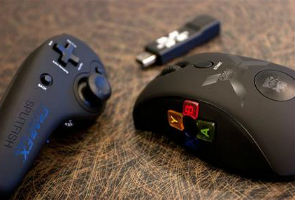- Home
- Games
- Games News
- Game maker without a rule book
Game maker without a rule book

Every way I look, the scene shifts, the battle unfolds. I have a crazy contraption strapped to my head: a boxy set of goggles that looks like a 22nd-century version of a View-Master. It immerses me in a virtual world. I whirl one way and see zombies preparing to snack on my flesh. I turn another and wonder what fresh hell awaits.
Behold the future of video games. Or at least the future as envisioned by a bunch of gamers, programmers, tinkers and dreamers at the Valve Corporation here. This is the uncorporate company that brought us the Half-Life series, the hugely influential first-person shooter game.
The Valve guys aren't done yet. Founded 16 years ago by a couple of refugees from Microsoft, Valve makes games that wild-eyed fans play until their thumbs hurt and dawn jabs through the curtains. But what really makes Valve stand out is its foresight on technology.
A decade ago, long before every media executive figured out that downloading was the future, Valve started an online service, Steam. It has since become for games what iTunes is to music - a huge online distributor, in its case one with more than 40 million active users and that, by some estimates, accounts for about 70 percent of the PC games bought and downloaded from the Web. Through Steam, Valve effectively collects a toll on other companies' online game sales, in addition to making money from selling its own products.
On Monday, the company will begin a public test of a new television-friendly interface, Big Picture, for buying Steam games and playing them on computers in the living room.
"They're on the cutting edge of the future of this industry," says Peter Moore, the chief operating officer of Electronic Arts, a big games publisher that is both a Valve competitor and partner.
Now Valve executives think they may be onto the next big thing in games: wearable computing. The goggles I'm wearing - reminiscent of the ones Google recently unveiled to much hoopla - could unlock new game-playing opportunities. This technology could let players lose themselves inside a virtual reality and, eventually, blend games with their views of the physical world.
It's one thing if a bottomless money well like Google wants to sink its profits into Project Glass, its own wearable-computing initiative. But for a 300-person software company like Valve, developing eyeball computers seems an absurdly ambitious - some say foolish - enterprise.
Valve's exploration of new forms of game hardware comes as the PC, the device on which it has depended for much of its history, is changing in ways that could undermine its business. With a new PC operating system, Windows 8, coming out in October, Microsoft will start its own online marketplace for distributing software, including games. The move could take some of the, well, steam out of Steam.
Valve fosters unorthodox thinking through a corporate culture unusual even by the quirky standards of technology companies. While many start-ups pay lip service to flat organizational structures, Valve emphasizes that its workplace is truly "boss-less."
"We don't have any management, and nobody 'reports to' anybody else," reads Valve's handbook for new employees, which generated buzz this year when it leaked onto the Web.
Forget silly-sounding Silicon Valley job titles like code jedi or chief listener. Valve has no formal titles. The few employees who've put titles on business cards do so to satisfy outsiders apprehensive about working with people without labels. The same applies to Gabe Newell, one of Valve's founders.
"I think he's technically the C.E.O., but it's funny that I'm not even sure of that," says Greg Coomer, a designer and artist who was one of Valve's first employees. (For the record, Mr. Newell is technically Valve's chief executive.)
To spur creativity, Google management created the concept of "20 percent time," the portion of employees' schedules that they could commit to entirely self-directed projects. At Valve, it's more like 100 percent time. New employees aren't even told where to work in the company. Instead, they are expected to decide on their own where they can contribute most. Many desks at Valve are on wheels. After figuring out what they want to do, workers simply push their desks over to the group they want to join.
A few years ago, a Valve hire who had worked in special effects in Hollywood balked at wheeling his desk. The news reached Mr. Newell, who promptly picked up the desk himself and carried it to the new location, to the new employee's embarrassment.
The man, whom Valve declined to name, is no longer with the company.
In an interview in a conference room at Valve's headquarters, Mr. Newell says that relatively few people have left Valve over the years. When they do, it's often because a sick parent needs help. In one case, Valve moved an employee's parents to the Seattle area, where one of them was also able to receive better cancer treatment.
"I get freaked out any time one person leaves," says Mr. Newell, a bearded bear of a man with John Lennon-style glasses. "It seems like a bug in the system."
THE company has been among its industry's leaders in engaging its audience. Valve won credibility early on with gamers by not merely tolerating the modification, or "modding," of its games with players' own creations but encouraging it.
The consistent originality of its games, too, has resonated with players. Portal 2 is a brainteaser that hinges on a mysterious weapon called a portal gun that a player can use to open entrances through walls, floors and ceilings, along with corresponding exits somewhere else. Players can use the gun to propel themselves across a chasm by jumping vertically into a hole and out a portal position on a wall.
The game has inspired an amusing string of fan videos in which gamers use homemade portal guns, and a dose of special effects, to cross a busy street and jump through walls of their homes.
Valve's teams, dedicated to games and other projects, are clustered in open spaces around the five floors of the skyscraper the company occupies in this city, across Lake Washington from Seattle. Vintage pinball machines are arrayed around its corridors, and doors throughout its offices are etched with tributes to Team Fortress, a Valve game that features an evil virtual corporation that hates its customers and sells them inferior products.
"Mann Co. We sell products and get in fights," reads the sign on the door in Valve's lobby.
Valve has an eclectic work force. The company became interested in hiring one artist only after learning that his pastime was spray-painting graffiti art in Britain. It recently hired Leslie Redd, a school administrator, to lead an effort to use "Portal" to teach physics and other subjects in schools by offering a more engaging way to present ideas like escape velocity. Ms. Redd said that more than 2,000 teachers worldwide had registered to use the game in classes.
This year, Mr. Newell hired Yanis Varoufakis, a Greek economist, after being impressed with Mr. Varoufakis's personal blog, which he fills with commentary on the European financial crisis. Mr. Varoufakis, who had never heard of Valve and is not a gamer, is studying the workings of the virtual economies of Valve games, in which players can barter and sell items like hats and armor. He said he was drawn to the job partly by Valve's "completely anti-authoritarian" culture that, to his surprise, seemed to be working.
"What does Valve have to add to our perception of the evolution of corporate structures in the future?" he said in a Skype interview from the Greek island of Aegina. "Let's face it, the current state of that culture leaves a lot to be desired."
Valve's most striking recruiting campaign is a recent move to establish a hardware group to develop technologies that can enhance the playing of games. The company posted a job listing for an industrial designer, hinting that it planned to get into the computer business itself. "We're frustrated by the lack of innovation in the computer hardware space, though, so we're jumping in," the listing read. "Even basic input, the keyboard and mouse, haven't really changed in any meaningful way over the years."
Valve also recruited Jeri Ellsworth, an inventor and self-taught chip designer, whose pinball machines decorate Valve's offices. Ms. Ellsworth recently gave a tour of Valve's hardware laboratory, proudly showing off 3-D printers, a laser cutter and other industrial tools used to cobble together hardware prototypes. While interviewing for the job, she said, she was dubious about Valve's interest in hardware.
"At one point, I said a hardware lab could be very expensive, it could be like a million dollars," she recalled. "Gabe said, 'That's it?' "
A DRIVING force behind Valve's most far-out hardware project, wearable computing, is being led by Michael Abrash, a veteran of technology and game companies who helped Valve get off the ground in the 1990s by licensing its important game software from his employer at the time, Id Software. To Mr. Abrash, glasses that project games in front of players' eyes are an obvious next step from today's versions of wearable computers, smartphones and tablets.
While Google's glasses will display texts and video conferences, Valve has greater technical challenges to overcome with augmented-reality games. It has to figure out how to keep stable an image of a virtual object (say, a billboard) that is meant to be attached to a real-world object (the side of a building) while a player moves around. Otherwise, the illusion would be shattered.
Mr. Abrash said glasses capable of credible augmented-reality games could be three to five years away, though he said virtual reality glasses would arrive sooner. He said Valve hadn't decided whether it would make glasses itself. But its ultimate goal is to share its designs freely so other hardware companies can make glasses, too.
"Gabe has a saying, which is, 'We will do what we need to do,' " Mr. Abrash says. "We don't particularly want to be a company that makes hardware in large quantities. It's not what we do."
Mr. Moore of Electronic Arts doubts that wearable-computing projects championed by the likes of Mr. Newell and Sergey Brin of Google will connect with the mainstream. "It's appealing to them because they live in that outer fringe of I.Q. and money," he says.
Mr. Newell's technology vision is one reason that his comments this summer about Windows 8, which he called a "catastrophe for everyone in the PC space," caused such an industry stir. He elaborated on some of his concerns more recently, saying he was troubled by a trend in computing toward devices that are less open to developers like Valve than they used to be. Apple kicked off the shift with its App Store for iOS devices, through which Apple controls the distribution of software that people can install on their iPhones and iPads, and takes a cut of the proceeds as well.
Mr. Newell concedes that this approach has been successful for Apple. He says, however, that he is concerned that Microsoft is taking a similar approach for Windows 8 applications, which will need to be distributed through a Microsoft app store if they take advantage of the most modern features in the operating system. Valve worries that Microsoft's control will undermine Steam on Windows 8 by creating a bottleneck for updates to games.
"We would say to Microsoft, we understand all these frustrations about the challenges to your business," he said. "But trying to copy Apple will accelerate, not slow, Microsoft's decline."
Mark Martin, a spokesman for Microsoft, declined to comment.
SOME game executives say it's ironic that such concerns come from Valve, which has become a gatekeeper with Steam. Last year, the company had a dust-up with Electronic Arts over Steam's policy of taking a cut of all revenue generated from a game, like the sale of virtual goods, even after a player has bought the game. As a result, E.A. is not selling a number of its latest games through Steam.
Valve says that without such a policy, developers could easily game the Steam system by making all their software free and charging consumers for additional content later. It is worth pointing out, too, that E.A. last year began competing directly against Steam by starting its own online game store, Origin.
Valve can do without many formalities of a traditional company because it's privately held and controlled by Mr. Newell. He and Mike Harrington, who is no longer with the company, founded Valve in 1996 with the wealth they accumulated in Microsoft's early days. The company has never raised money from outside investors, so it is under no external pressure to sell itself or go public.
Not that Mr. Newell hasn't had opportunities to sell out. Valve has been pursued over the years by Electronic Arts, which would very likely have valued Valve at well over $1 billion had the talks progressed that far, said two people with knowledge of the discussion who spoke on condition of anonymity because the talks were private.
Although Valve's finances are private, Michael Pachter, an analyst at Wedbush Securities, estimates that the company could be worth around $2.5 billion today.
Mr. Newell said that there was a better chance that Valve would "disintegrate," its independent-minded workers scattering, than that it would ever be sold.
"It's way more likely we would head in that direction than say, 'Let's find some giant company that wants to cash us out and wait two or three years to have our employment agreements terminate,' " he says.
David Lonczak, vice president for e-commerce marketing for Drugstore.com, Beauty.com and Walgreens.com, said that the change has spurred him to look at advertising alternatives, but that he has no choice other than to list his products on Google Shopping as well.
"It would be one of those cut-off-your-nose-to-spite-your-face kinds of things," he said.
Wayfair, the large online furniture store, previously sent feeds with all its products to Google. Now it expects to pay to list just 40 percent of its merchandise.
Google would not say how many retailers were paying for listings, except to say there was "significant participation."
ChannelAdvisor, a marketing firm for e-commerce companies, said that among the hundreds of retailers it manages, 63 percent have begun paying. For those sites, revenue per click on a product listing has tripled. One, ToolKing.com, an online hardware store, said traffic from Google and the number of people who make purchases had both risen more than 50 percent.
If retailers slash the number of products they list on Google, shoppers could hunt elsewhere - like Amazon - for more comprehensive listings.
"Eventually someone says, 'I'm not going to pay,' " said Kristopher Kubicki, co-founder of Dynamite Data, which monitors e-commerce sites for its retail clients. "And sooner or later, the consumer stops trusting the application because it's not really a comparison anymore. It's just an ad."
Copyright 2012 The New York Times News Service
Get your daily dose of tech news, reviews, and insights, in under 80 characters on Gadgets 360 Turbo. Connect with fellow tech lovers on our Forum. Follow us on X, Facebook, WhatsApp, Threads and Google News for instant updates. Catch all the action on our YouTube channel.
Related Stories
- Samsung Galaxy Unpacked 2025
- ChatGPT
- Redmi Note 14 Pro+
- iPhone 16
- Apple Vision Pro
- Oneplus 12
- OnePlus Nord CE 3 Lite 5G
- iPhone 13
- Xiaomi 14 Pro
- Oppo Find N3
- Tecno Spark Go (2023)
- Realme V30
- Best Phones Under 25000
- Samsung Galaxy S24 Series
- Cryptocurrency
- iQoo 12
- Samsung Galaxy S24 Ultra
- Giottus
- Samsung Galaxy Z Flip 5
- Apple 'Scary Fast'
- Housefull 5
- GoPro Hero 12 Black Review
- Invincible Season 2
- JioGlass
- HD Ready TV
- Laptop Under 50000
- Smartwatch Under 10000
- Latest Mobile Phones
- Compare Phones
- OnePlus 15R
- Realme Narzo 90x 5G
- Realme Narzo 90 5G
- Vivo S50 Pro Mini
- Vivo S50
- OPPO Reno 15c
- Redmi Note 15 5G
- Redmi Note 15 Pro 5G
- Asus ProArt P16
- MacBook Pro 14-inch (M5, 2025)
- Infinix Xpad Edge
- OnePlus Pad Go 2
- OnePlus Watch Lite
- Just Corseca Skywatch Pro
- Acerpure Nitro Z Series 100-inch QLED TV
- Samsung 43 Inch LED Ultra HD (4K) Smart TV (UA43UE81AFULXL)
- Asus ROG Ally
- Nintendo Switch Lite
- Haier 1.6 Ton 5 Star Inverter Split AC (HSU19G-MZAID5BN-INV)
- Haier 1.6 Ton 5 Star Inverter Split AC (HSU19G-MZAIM5BN-INV)

















